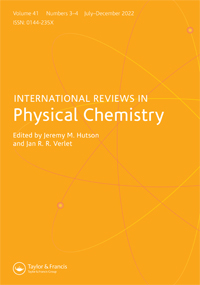Energetics and dynamics of CH4 and H2O dissociation on metal surfaces
IF 2.5
2区 化学
Q3 CHEMISTRY, PHYSICAL
引用次数: 8
Abstract
Dissociative chemisorption is one of the most significant steps in heterogeneous catalysis. The rate-limiting step for industrially important processes such as water gas-shift reaction and steam reforming of methane involves the dissociative chemisorption of water and methane, respectively. These reactions exhibit interesting mode-specificity and show a strong dependence on the surface temperature of the catalyst. The metals commonly used in industry as catalysts for these two processes have their own limitations. Certain bimetallic surfaces and subsurface alloys are suggested, which could be regarded as potential catalysts for these two industrial processes. How transition states are modified by the motion of the lattice atom during the reactions are shown using electronic structure calculations. In the present review, we have focused on the lattice atom distortion in the transition state, semi-classical tunnelling probability, and the influence of surface temperature on reactivity. Quantum dynamics study for H O dissociation on metal surface is explored using three-dimensional London-Eyring-Polanyi-Sato potential energy surface. A full quantum mechanical approach following reaction path Hamiltonian is also studied by including the effects of lattice motion and site averaging. The effects of initial vibrational mode on reactivity are reported. Vibrational efficacy is examined in terms of vibrational non-adiabatic couplings.金属表面CH4和H2O解离的热力学和动力学
解离化学吸附是多相催化中最重要的步骤之一。工业上重要的过程,如水煤气变换反应和甲烷的蒸汽重整,其限速步骤分别涉及水和甲烷的解离化学吸附。这些反应表现出有趣的模式特异性,并表现出对催化剂表面温度的强烈依赖性。工业上常用的金属作为这两种工艺的催化剂有其自身的局限性。提出了某些双金属表面和亚表面合金,它们可以被视为这两种工业过程的潜在催化剂。利用电子结构计算表明了反应过程中晶格原子的运动如何改变过渡态。本文主要研究了跃迁态的晶格原子畸变、半经典隧穿概率以及表面温度对反应性的影响。利用三维London-Eyring-Polanyi-Sato势能面对金属表面氢氧解离进行了量子动力学研究。通过考虑晶格运动和位置平均效应,研究了反应路径哈密顿量的全量子力学方法。报道了初始振动模式对反应性的影响。从振动非绝热耦合的角度考察了振动效率。
本文章由计算机程序翻译,如有差异,请以英文原文为准。
求助全文
约1分钟内获得全文
求助全文
来源期刊
CiteScore
14.20
自引率
1.60%
发文量
5
审稿时长
1 months
期刊介绍:
International Reviews in Physical Chemistry publishes review articles describing frontier research areas in physical chemistry. Internationally renowned scientists describe their own research in the wider context of the field. The articles are of interest not only to specialists but also to those wishing to read general and authoritative accounts of recent developments in physical chemistry, chemical physics and theoretical chemistry. The journal appeals to research workers, lecturers and research students alike.

 求助内容:
求助内容: 应助结果提醒方式:
应助结果提醒方式:


